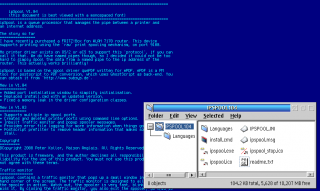|
IP Spool v. 1.04 (9/1/2009) |
Readme/What's new |
===========================================================================
ipSpool V1.04
(this document is best viewed with a monospaced font)
===========================================================================
ipSpool is a queue processor that manages the pipe between a printer and
an internet address.
The story so far
================
I have recently purchased a FRITZ!Box fon WLAN 7170 router. This device
supports printing using the 'raw' print spooling mechanism, on port 9100.
No printer driver exists on OS/2 or eCS to support this 'protocol', if you can
call it that. We do have named pipes though, so I decided it could not be too
hard to simply spool the data from a named pipe to the ip address of the
router. This actually works brilliantly!
ipSpool is based on the spool driver quePDF written for ePDF. ePDF is a PM
tool for postscript to PDF conversion, which uses GhostScript as back-end. You
can obtain it from 'http://www.subsys.de'.
New in V1.04
============
* Added port installation window to simplify initialisation.
* Replaced install.cmd with an updated version.
* Fixed a memory leak in the driver configuration classes.
New in V1.03
============
* Supports multiple ip spool ports.
* Creates and deletes printer ports using command line options.
* Inbuilt Traffic monitor and popup spooler messages.
* Provides error file logging for more information when things go wrong.
* Postscript prefilter to remove header information that makes some printers
stall.
Copyright
=========
©Copyright 2008 Peter Koller, Maison Anglais. All Rights Reserved
This product is freeware, and the author declines all responsibility and
liability for the use of this product. You must not use this product if you do
not agree with these terms.
Traffic monitor
===============
ipspool contains a traffic monitor that pops up a small window in the top left
hand corner of the screen. The traffic monitor is designed to allow you to see
the spooler in action. Watch out, the spooler is very fast, blink and you will
miss it. By closing the traffic monitor, you also exit the spooler, so this is
a very handy feature for testing. The traffic monitor is an alternative to the
default popup spooler messages.
Install Utility
===============
The installer provides a convenient utility to setup and configure printer
ports. The feature that is not currently supported is the enabling of the
postscript filter. If you need to configure a filtered postscript port, please
follow the instructions below.
Port configuration using ipSpool
================================
If ipSpool is running, stop it. From a command line, run ipSpool with the /i
flag:
c:\>ipspool.exe /i
Switch on your printer, fill in the required port information, and click on
the 'Add/Change' button. Use the 'Clear' button to remove unwanted ports. You
can use this window to set and remove ports at will.
Installation
============
1) Copy or unzip the spooler into it's own folder on your hard disk.
2) Run 'install.cmd' to create a desktop object.
3) Use ipspool command parameters:-
/h or /?
- Shows a help message
/hports or /?ports
- Shows the installed port configuration
/q - makes the spooler quiet, no 'spooling' message!
/l - enables logging to a logfile 'ipspool.log', which can become
very large!
/c or /i
- without parameters a dialog is shown to help you set up your ports.
/c<pipe> or /i<pipe>
- attach to a named pipe - the pipe is created if it does not exist,
make sure that at least /a and /p are also specified. Also, see the /f
command. The printer must be attached and switched on.
/d<pipe>
- disconnect from a named pipe - the pipe is deleted if possible.
/a<ip-addr>
- an ip address, the default is /a192.168.1.1
/p<port>
- the port number, the default is /p9100
/n<description>
- the description of the port, the default is none.
/f
-filter this port to cleanup postscript data
/t
-start ipspool with the traffic monitor to see the spooler in action.
Examples:
---------
x:>ipspool /iipspool /a192.168.1.1 /p9100 /nspoolport /f
Creates the named pipe /pipe/ipspool, and connects to it. You will get a
message, and then the spooler will exit. You must then select the port in
the printer properties of the printer. If postscript data is found, it will
be filtered.
x:>ipspool /dipspool
Destroys the named pipe /pipe/ipspool. You will get a message, and then the
spooler will exit.You must first deselect the port in the printer
properties of the printer, or the command will fail.
x:>ipspool /q
Starts the spooler in quiet mode. The spooler will process print data as it
arrives.
x:>ipspool /t
Starts the spooler and the traffic monitor. The spooler will process print
data as it arrives.
4) Drag and copy the program desktop object into your startup folder to start
ipSpool automatically.
Languages
=========
At the moment, ipSpool is provided with english resources only. You can
translate the resources supplied in the languages folder and compile them
using msgc.exe and ipsmsg.cmd. |



Add new comment